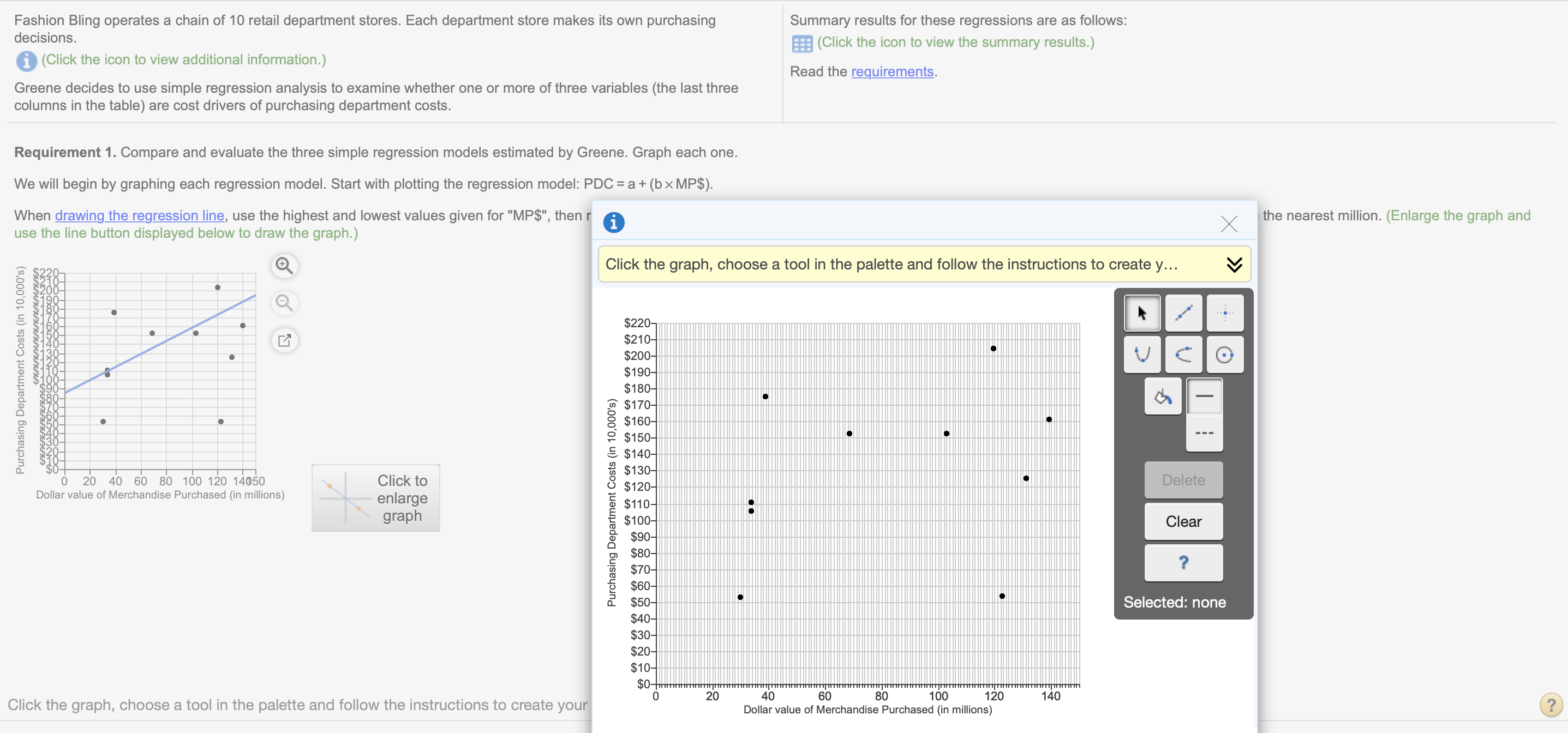Answered step by step
Verified Expert Solution
Question
1 Approved Answer
Fashion Bling operates a chain of 10 retail department stores. Each department store makes its own purchasing decisions. (Click the icon to view additional


Fashion Bling operates a chain of 10 retail department stores. Each department store makes its own purchasing decisions. (Click the icon to view additional information.) Greene decides to use simple regression analysis to examine whether one or more of three variables (the last three columns in the table) are cost drivers of purchasing department costs. Requirement 1. Compare and evaluate the three simple regression models estimated by Greene. Graph each one. We will begin by graphing each regression model. Start with plotting the regression model: PDC = a + (bx MP$). When drawing the regression line, use the highest and lowest values given for "MP$", then r use the line button displayed below to draw the graph.) 1 Summary results for these regressions are as follows: (Click the icon to view the summary results.) Read the requirements. Click the graph, choose a tool in the palette and follow the instructions to create y... Purchasing Department Costs (in 10,000's) . $220- . $210- . . $200- $190 $180- . 0 20 40 60 80 100 120 14050 Dollar value of Merchandise Purchased (in millions) Click to enlarge graph Purchasing Department Costs (in 10,000's) $170- $160- $150- $140- $130- $120 $110 $100- $90- $80- $70- $60- $50- $40- $30- $20- $10- $0- 0 Click the graph, choose a tool in the palette and follow the instructions to create your =20 40 60 100 Dollar value of Merchandise Purchased (in millions) 80 120 140 8 U the nearest million. (Enlarge the graph and Delete Clear ? Selected: none More Info Click the icon to view the summary results.) the requirements. Jeff Greene, assistant to the president of Fashion Bling, is interested in better understanding the drivers of purchasing department costs. For many years, Fashion Bling has allocated purchasing department costs to products on the basis of the dollar value of merchandise purchased. A $100 item is allocated 10 times as many overhead costs associated with the purchasing department as a $10 item. Greene recently attended a seminar titled "Cost Drivers in the Retail Industry." In a presentation at the seminar, Calico Fabrics, a leading competitor that has implemented activity-based costing, reported number of purchase orders and number of suppliers to be the two most important cost drivers of purchasing department costs. The dollar value of merchandise purchased in each purchase order was not found to be a significant cost driver. Greene interviewed several members of the purchasing department at the Fashion Bling store in Miami. They believed that Calico Fabrics' conclusions also applied to their purchasing department. Greene collects the following data for the most recent year for Fashion Bling's 10 retail department stores: ts to the nearest increment of $10.000 and merchandise purchased to the nearest million. (Enlarge the graph and Data Table Regression 1: PDC = a + (b x MP$) Variable Constant Coefficient Standard Error t-Value $ 1,053,189 $ Independent variable 1: MP$ 0.0030 344,126 0.0037 3.06 0.80 r = 0.08; Durbin-Watson statistic = 2.41 Regression 2: PDC = a + (b x No. of POs) Variable Purchasing Dollar Value of Department Merchandise Number of Purchase Orders Number of Suppliers Baltimore Department Store $ 1,530,000 $ Constant $ Costs (PDC) Purchased (MP$) (No. of POs) (No. of Ss) Independent variable 1: No. of POS $ 736,340 $ 155.73 $ Coefficient Standard Error t-Value 266,047 64.84 2.77 2.40 68,310,000 4,320 135 r = 0.42; Durbin-Watson statistic = 1.99 Chicago 1,110,000 33,460,000 2,560 220 Regression 3: PDC = a + (b x No. of Ss) Los Angeles 540,000 122,500,000 1,430 10 Variable Coefficient Standard Error t-Value Miami 2,045,000 119,575,000 5,955 195 Constant $ 785,458 $ 244,849 3.21 New York 1,060,000 33,515,000 2,790 25 Independent variable 1: No. of Ss $ 4,094 $ 1,677 2.44 Phoenix 535,000 29,950,000 1,320 36 r = = 0.43; Durbin-Watson statistic = 1.96 ? Seattle 1.530.000 102.890.000 7.595 110 Print Done Print Done
Step by Step Solution
There are 3 Steps involved in it
Step: 1
To compare and evaluate the three simple regression models lets follow the steps outlined below Each model will be graphed and analyzed individually M...
Get Instant Access to Expert-Tailored Solutions
See step-by-step solutions with expert insights and AI powered tools for academic success
Step: 2

Step: 3

Ace Your Homework with AI
Get the answers you need in no time with our AI-driven, step-by-step assistance
Get Started


